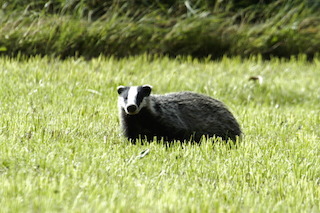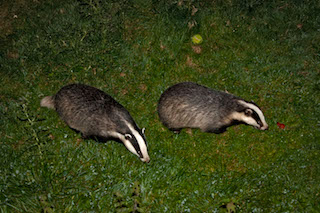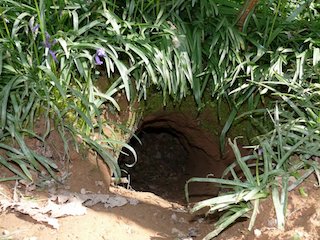 With its striking black and white striped head, the badger is one of our most instantly recognisable mammals.
With its striking black and white striped head, the badger is one of our most instantly recognisable mammals.
Photo: James Lindsey
Scientific name: Meles meles
Cornish name: Brogh
Conservation status: IUCN, Least Concern; Protection of Badgers Act 1992
What to look for:
- Appearance and colouring: The badger has a striking black and white striped head; the rest of the stocky body appears grey, and the legs, throat, neck, chest and belly are black. The tail is a whitish colour but can be darker. Males and females are similar in appearance, although females tend to be slightly smaller in size. Badgers have short, powerful legs with well-developed claws on each foot which they use both in digging their tunnels and in searching for food.
- Size: Head and body length: 750 mm; tail length: 150 mm; weight (spring): 8 to 9 kg; weight (autumn): 11 to 12 kg
- Where: Found throughout England, Wales, most of Scotland except for the far north, and Northern Ireland. Absent from Scottish Islands, the Isle of Man, the Isles of Scilly and Channel Islands. The badger is well recorded across Cornwall, with numbers stable or possibly increasing over the last 40 years, where it may be found on farmland, grassland, heathland, woodland, towns and gardens.
 The Badger is our biggest land predator, a member of the Mustelid family and related to Stoats, Weasels and Otters. The Badger is just as common as the Red Fox, but more nocturnal and elusive in its habits. Badgers live in large family groups in a burrow system known as a ‘sett’. An occupied sett can be recognised by the tidy burrow entrances, marked with piles of used bedding (hay and leaves), and by nearby latrine pits where they leave their droppings. Badgers are incredibly clean and will not defecate in or bring food into their sett.
The Badger is our biggest land predator, a member of the Mustelid family and related to Stoats, Weasels and Otters. The Badger is just as common as the Red Fox, but more nocturnal and elusive in its habits. Badgers live in large family groups in a burrow system known as a ‘sett’. An occupied sett can be recognised by the tidy burrow entrances, marked with piles of used bedding (hay and leaves), and by nearby latrine pits where they leave their droppings. Badgers are incredibly clean and will not defecate in or bring food into their sett.
Males (boars) may be up to 90 cm long and weigh about 12 kg, although badgers have been recorded weighing over 27 kg. Females (sows) are generally smaller. Usually, only a single female in each group will breed each year, giving birth to up to five young. Cubs are born in January or February, but spend the first two or three months underground, only emerging in the spring. Clans occupy territories of 30 to 150 ha around the sett, often including areas of pasture and arable fields.
 Badgers are opportunistic foragers with an omnivorous diet, including fruit and nuts, roots, bulbs, and tubers (which they dig up with their strong front paws), acorns, and cereal crops. They also consume a variety of invertebrates (especially earthworms), the contents of wasp and bee nests, ground-nesting birds’ eggs, carrion, and live vertebrate prey such as hedgehogs, moles, and rabbits.
Badgers are opportunistic foragers with an omnivorous diet, including fruit and nuts, roots, bulbs, and tubers (which they dig up with their strong front paws), acorns, and cereal crops. They also consume a variety of invertebrates (especially earthworms), the contents of wasp and bee nests, ground-nesting birds’ eggs, carrion, and live vertebrate prey such as hedgehogs, moles, and rabbits.
Did you know…?
…The badger’s name is said to derive from the French bêcheur, meaning digger.
…There are estimated to be 250,000 to 300,000 badgers in Britain.
…Badgers are nocturnal, meaning they are most active at night and sleep during the day.
…The average lifespan in the wild is between 4 and 10 years, but some badgers may live up to 14 years. In captivity, they have been known to live up to 26 years.
…European badgers are the most social of badger species, forming groups of six adults on average, though larger associations of up to 23 individuals have been recorded.
…Badgers groom each other very thoroughly with their claws and teeth.
…European badgers have an extensive vocal repertoire. When threatened they emit deep growls and when fighting make low kekkering noises. They bark when surprised, whicker when playing or in distress, and emit a piercing scream when alarmed or frightened.
 …If a badger dies within the sett, other badgers within the sett will seal off the chamber and dig a new one. Some badgers will drag their dead out of the sett and bury them outside.
…If a badger dies within the sett, other badgers within the sett will seal off the chamber and dig a new one. Some badgers will drag their dead out of the sett and bury them outside.
…They may share their setts with red foxes or rabbits. The badgers may provide protection for the rabbits against other predators. The rabbits usually avoid predation by the badgers by inhabiting smaller, hard-to-reach chambers.
…Badgers have excellent hearing and sense of smell, but their eyes are small and their eyesight is relatively poor.
…There are lots of different types of setts in a territory but the main sett is the biggest. Some main setts are hundreds of years old and have hundreds of entrances, too!
More information and references:
Mitchell-Jones, A. J. et al., 1999. The Atlas of European Mammals. Academic, London.
Environmental Records Centre for Cornwall and the Isles of Scilly (ERCCIS), Truro, Cornwall.
Groves, D., 2013. The Mammals of Cornwall and the Isles of Scilly. Cornwall Mammal Group. ERCCIS, Truro, Cornwall.
Published: February 2019
Author: Debbie Sea-Kay
Photos: Entrance to badger sett (Hildesvini, CC0); badger in field (James Lindsey, CC BY-SA 3.0); foraging badgers (Mark Robinson, CC BY 2.0)
